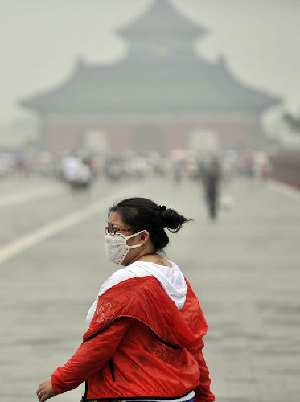 The 4th Chinese National Pole Dance Championship held in Tianjin
The 4th Chinese National Pole Dance Championship held in Tianjin
 Chinese navy commandos debut at 2014 RIMPAC
Chinese navy commandos debut at 2014 RIMPAC
 Guangxi impression: scenic countryside
Guangxi impression: scenic countryside
 World's largest aquatic insect found in Sichuan
World's largest aquatic insect found in Sichuan
 Ceremony volunteers for Youth Olympics make public appearance
Ceremony volunteers for Youth Olympics make public appearance
 A glimpse of female crew of Liaoning aircraft carrier
A glimpse of female crew of Liaoning aircraft carrier
 Stills from "Dad, where are we going?"
Stills from "Dad, where are we going?"
 Legless man's happy life
Legless man's happy life
 Top ten most beautiful islands in China
Top ten most beautiful islands in China
 Aerial view of Hong Kong
Aerial view of Hong Kong
 |
| A mask-wearing woman walks in the Temple of Heaven during an extremely smoggy day in Beijing in July. Li Wen / Xinhua |
Beijing will issue a new urban planning strategy by the end of this year that will for the first time contain a plan to preserve large and green "air corridors".
An urban air corridor is a new field being researched by ecological departments both at the city and national levels.
Liu Chunlan of the Beijing Research Institute of Environmental Protection said the corridors will be wide tracts of land along the direction of Beijing's prevailing winds that could help disperse pollutants and hot air.
Experts said the corridors will likely play a significant role in the prevention and control of small particulate matter, including PM2.5 - particulate matter with a diameter of less than 2.5 microns that can penetrate the lungs and seriously harm health.
Liu said the use of air corridors will be a key topic in Beijing's new city planning strategy. She said current research will mainly focus on locating the city's major air corridors and coming up with ideas for how to preserve them.
"The type of air corridor that may have the functions we desire - such as helping disperse pollutants and heat - should be long and wide enough with plenty of green foliage," Liu said. "We would like to control the density and height of buildings along the city's major air corridors."
But she admitted that it will be tough work because the city has more than six ring roads and not much space remaining in the downtown area.
Experts, however, have shifted their attention to Beijing's suburbs to help solve the problem of dispersing pollutants out of Beijing's urban areas.
According to the Economic Research Institute at the Beijing Academy of Social Sciences in late July, a severely polluted route from Nankou to Machikou along the Beijing-Tibet Highway in northwest Beijing's Changping district lies in a major wind pattern that blows into the capital's downtown area. Under poor weather conditions, this route aggravates the smog in the city center.
The institute's report said that in an area of about 10 square kilometers along the route, there are many heavy-polluting industries. The city government should clear the area of all of industrial facilities, the report suggested.
Peng Yingdeng, a researcher from the Beijing Research Institute of Environmental Protection, said the suggestion has gained traction among experts. Peng added that pollution control in northwest Beijing would at least help disperse pollutants in the Changping and Haidian districts.
But they may not be able to help the rest of the city.
"For most parts of the downtown area, counting on air corridors in the suburbs to reduce pollution levels may not be realistic," said Zhang Zengjie, another researcher from the Beijing Research Institute of Environmental Protection.
Reducing emissions intensity may be the best solution for the densely populated downtown area because it would be hard to demolish buildings to make way for an air corridor, he said.
 Blockbuster? No, it’s firefighters’ posters
Blockbuster? No, it’s firefighters’ posters
 Special 'gifts' for IT men for Chinese Qixi Festival
Special 'gifts' for IT men for Chinese Qixi Festival
 Foreign students' colorful life in China
Foreign students' colorful life in China
 French photographer‘s work 'China 2050' goes viral online
French photographer‘s work 'China 2050' goes viral online A bite of Halal Food
A bite of Halal Food
 Dressed in uniforms to marry you
Dressed in uniforms to marry you
 Female soldier in Chinese special force
Female soldier in Chinese special force
 Zhujiang ambassadors attend lotus lanterns activity
Zhujiang ambassadors attend lotus lanterns activity
 From girly girl to tough special police officer
From girly girl to tough special police officer
 22-year-old veteran travels around China
22-year-old veteran travels around China
 Night scenery of pagoda forests
Night scenery of pagoda forests China suffers from hot summer
China suffers from hot summer 48 hours after super Typhoon Rammasun
48 hours after super Typhoon Rammasun German pianist plays mid-air ‘magic carpet’ show over Munich Airport
German pianist plays mid-air ‘magic carpet’ show over Munich Airport
 China's manned deep-sea submersible conducts dive in Pacific Ocean
China's manned deep-sea submersible conducts dive in Pacific Ocean
Day|Week|Month